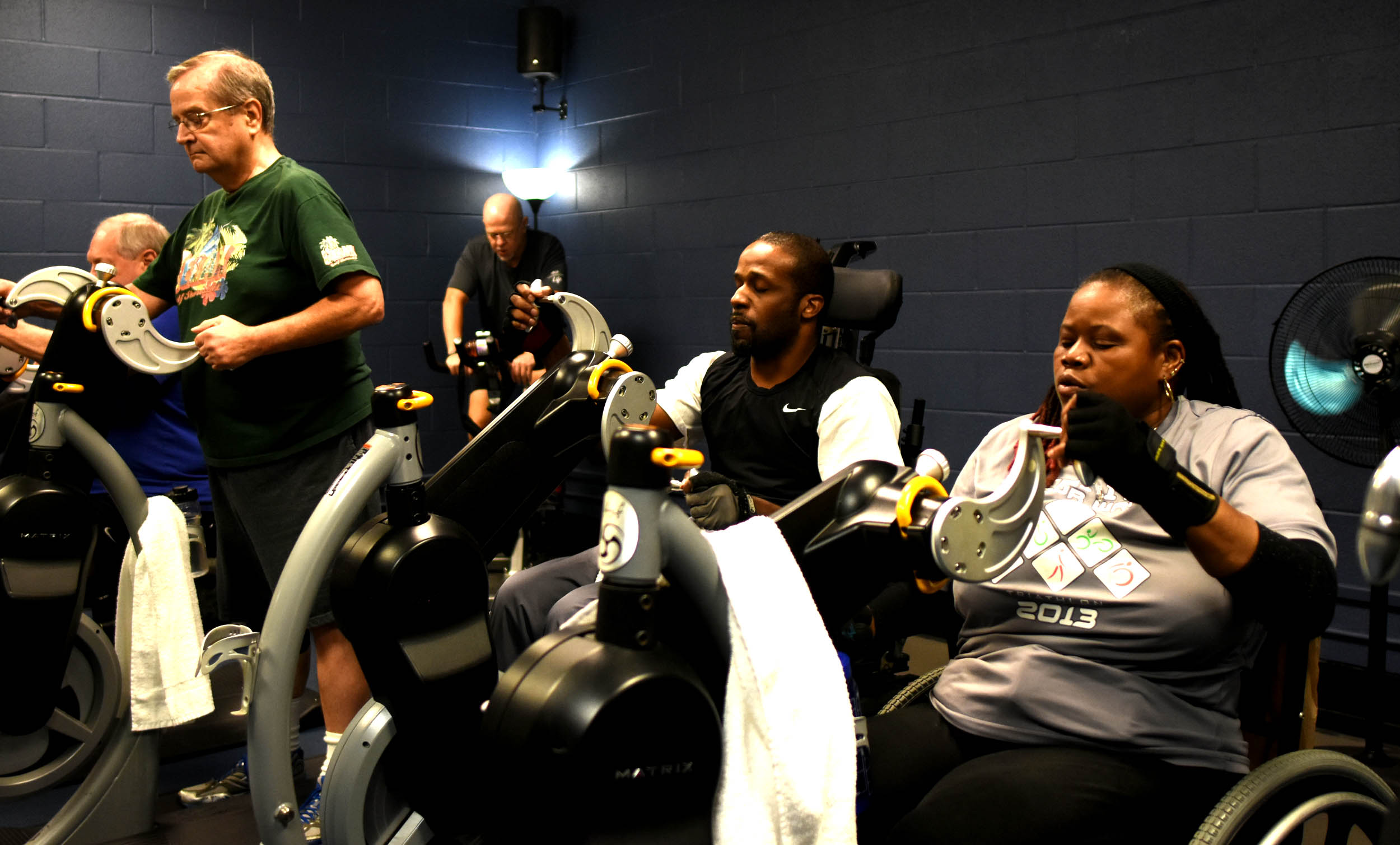By Solomon Crenshaw Jr.
For the Birmingham Times

Dwellyn Jackson of College Hills has multiple sclerosis, which saps his muscles of strength. If left alone, the 41-year-old might barely have enough energy to operate his motorized wheelchair. But five-times-a-week trips to the Lakeshore Foundation in Homewood enable him to participate in activities that allow him to retain his strength.
Jackson takes part in a class called Kranking, during which he turns the handles of a Krankcycle, a stationary arm bike used in a manner similar to that of a cyclist pedaling on a stationary bike in a Spin class. He also lifts weights, participates in Zumba classes, and swims—all because the Lakeshore Foundation provides a place for him and others with physical disabilities.
“It’s heaven-sent,” said Jackson, who lives in Birmingham with his mother during the week and in Montgomery with his wife and son on weekends. “There’s nothing like it.”
New Course
The Lakeshore Foundation, established in 1923 as the Jefferson Tuberculosis Sanatorium, began providing opportunities for individuals with physical disabilities in the early 1970s and completed its transition to Lakeshore Rehabilitation Hospital in 1973.
The Lakeshore board decided that the sports and recreation work done by the hospital for people with disabilities needed to have its own home, so in 1984 the Lakeshore Foundation was formed.
A new course was charted in 2001, with construction of the Lakeshore Foundation Fieldhouse that continued to build on the vision of its founder, Michael Stephens, who died on July 1 of this year.
“This building is a platform for a lot of new things that we’ve done,” said Jeff Underwood, Lakeshore Foundation President and CEO, citing the facility’s 2003 designation as a U.S. Olympic and Paralympic Training Site and the addition of a robust research program. “Those are two things we couldn’t have done in the old space that we had.”
World-Class
The Lakeshore Foundation includes a heated indoor aquatics center with two pools; a 6,000-square-foot fitness area with free-weights, strength-training and cardio machines, and a group exercise studio; a three-court gym; a 200-meter indoor Olympic Mondo-surface track; and a six-lane archery and marksmanship range. It also has newly renovated spacious men’s and women’s locker room facilities, which include five private assisted dressing rooms and two poolside bathrooms.
“You don’t see restrooms here that are marked [wheelchair] accessible because they all are,” Underwood said. “That’s part of the change in attitude here. We don’t set aside certain areas as being accessible. Everything’s accessible. Everything’s inclusive.”
The aquatics center’s pools are designed to serve different purposes. The four-lane, 25-meter pool is maintained at approximately 92 degrees to accommodate classes that focus on pain management and range of motion. And the eight-lane, 25-yard pool is maintained at about 86 degrees to meet more cardiovascular needs in water-aerobics classes, as well as lap swimming and competitive athletics. Both pools are accessible and offer multiple ways of entry and exit for people with varying levels of ability.
“This building has allowed us to serve more people in better ways and be a stronger organization,” said Underwood. “It’s clearly not only the building but also the complement of staff who work here day in and day out to make things happen.”

‘Embracing Spirit’
In addition to serving as a U.S. Olympic and Paralympic Training Site, the Lakeshore Foundation is home of USA Wheelchair Rugby and currently has 13 other athletic teams that compete in a wide range of individual and team sports—for athletes ranging from 6-year-olds who are just starting out to adults who have qualified for the Paralympic Games.
“Lakeshore has become a superstar among rehabilitation facilities, nationally and internationally,” said Anita Smith, author of “Sports Rehabilitation and the Human Spirit: How the Landmark Program at the Lakeshore Foundation Rebuilds and Restores Lives.”
“It is a combination of their model, prototype programs combined with an embracing spirit that is really hard to define,” she said. “But it is very much a contributor to the success of their programs.”
That spirit comes not only from how staff members interact with patrons but also how patrons interact with each other and how their families interact, Smith said.
“That all combines to form a network of a spirit,” she said. “Mix that in with the high-quality, well-thought-out programs, and you’ve got a superstar, prototype facility.”

‘Can Do’
Carol Kutik, Lakeshore Foundation Director of Health Promotion and Fitness, said it’s not about what a person can’t do: “It’s what you can do and how to do it within your body’s ability.”
“It’s about ability,” she said. “And everybody’s ability looks a little different.”
The Lakeshore Foundation has made headlines with its disabled sports program that yielded its designation from the U.S. Olympic Committee. It has also earned attention for its Lima Foxtrot programs for injured military, a series of comprehensive, year-round, sport, recreation, and fitness activities for members of the Armed Forces severely injured after the devastating Sept. 11 attacks. But those high-profile programs don’t tell the whole story.
“The heart and soul of this organization are the people who, for the most part, live in central Alabama, in the Birmingham region, who can come here every day,” Underwood said. “They’re doing everything they can to stay as healthy and as active as they can despite dealing with some kind of health issue. They know how important physical activity is for their health and how important their health is to being independent.
“They come here to be active so they can be healthy,” he said. “That’s clearly the bulk of what we do.”
Click here for other stories about Lakeshore Foundation.




